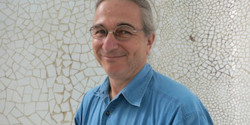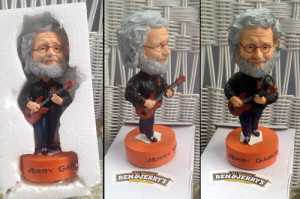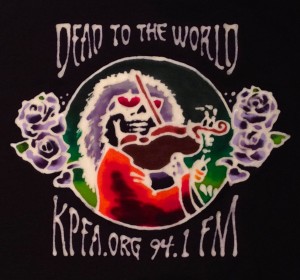This weekend and through February David Gans will celebrate two milestones: his 29th Grateful Dead marathon on listener supported KPFA-FM in Berkeley and his 30th year of radio broadcasting. A musician and writer, Gans deejayed his first Deadhead Hour on KFOG-FM in San Francisco on February 18, 1985. He has hosted the weekly show Dead to the World on KPFA since 1990.
Gans will team up with his colleague Tim Lynch on Saturday starting at 9 AM to broadcast unreleased recordings from the Grateful Dead archive plus live in-studio performances. Lots of items will be auctioned off prior to the marathon, all the proceeds going to KPFA. Quincy McCoy, the station’s general manager, is understandably appreciative of this windfall. “The Dead have kept KPFA alive for many years,” McCoy commented this week in anticipation of the ‘thon.
I emailed some questions to Gans about his life and work and he responded in considerable detail. Here is our conversation:
Radio Survivor: David, when was the moment that you realized that you were going to start doing some kind of radio show on the Grateful Dead? What was going on in your life?
David Gans: I wrote a book in 1984 called Playing in the Band: An Oral and Visual Portrait of the Grateful Dead. In advance of its publication in the spring of 1985, I was invited to appear on the KFOG Deadhead Hour, a weekly feature that had been started by PD Dave Logan in November ’84. With the help of KFOG DJ Bonnie Simmons, I put together a short feature on the fascinating story behind the creation of “Greatest Story Ever Told,” a song that began with a recording of a pump at Mickey Hart’s ranch. I had audio from Hart, Bob Weir, and lyricist Robert Hunter, and Mickey was kind enough to pull the master reel out and spin off samples the pump and other elements that went into his recording. I filled out that hour with some recent live recordings of the Grateful Dead.
The host of the show, M Dung, was a pretty seriously overworked dude at the time. He was the Monday to Friday morning-drive host – which is a really punishing schedule for a rock’n’roller who doubtless would rather have been heading for bed at 3 AM than getting up for work at that hour – plus he had his own specialty show, The Sunday Night Idiot Show. So he was relying on a couple of local Deadheads to supply him with music. I became one of those contributors.
I really enjoyed putting that feature together, and I had a good enough relationship with the Dead at the time that I was able to get music from their archive. Within a few months, KFOG had asked me to take responsibility for the program, which I was really glad to do. Radio was fun, and I had time to do it in between my responsibilities as an editor at two magazines.
I never really planned to get into radio – it just kinda happened. Bonnie introduced me to her colleagues Bill Keffury and Scoop Nisker, both of whom gave me practical instruction as well as inspiration (Scoop had been a hero of mine for years!).
Radio Survivor: How did you get from KFOG to KPFA?
David Gans: After I took over the KFOG Deadhead Hour, I started getting calls from other stations, asking if they could air my show. KFOG offered no objection, and asserted no ownership of the program I was doing; the Grateful Dead gave their permission as well, and so – again, without ever making any plan to do so – I began to distribute The Deadhead Hour nationally. WHCN (Hartford CT) was my first affiliate; a classic rock station in San Diego (KZLX, I think) was next; and then with WNEW-FM I was on my way.
Radio Survivor: How much of your 30 year career doing Grateful Dead programming has brought you into direct partnership or contact with members of the Grateful Dead?
I already had relationships with the band and their staff. I had engaged them as a journalist starting in 1977, and I had the support of a couple of the band members when the book happened. They supported me in the broadcasting endeavor, too.
Before my first year of self-syndication was complete, I began talking with national syndicators. Westwood One made me an offer that I found insufficient, and I talked with some others. MJI Broadcasting made me an offer that I (and the Dead) liked a lot: it gave me control over content and a budget to secure some good-quality production gear.
The syndication deal didn’t yield the results that MJI was hoping for. They made me a low-ball offer for a second year; I said no, and began distributing the program myself again. I began to migrate toward public and community radio, where the listenership could more easily affect programming decisions. I made a pitch to WXPN in Philadelphia: play a few GD Hours during your fund drive, and it will raise enough money to pay for the show for some time period. That worked, and XPN still airs the GD Hour.
By this time I had a relationship with KPFA. The station asked me to host a fund-raising special in 1986 – I can’t remember if this was before or after the live broadcast from the Greek Theater (up the hill on the UC Berkeley campus) on June 22. I was involved in KPFA broadcasts from the Greek in 1987, 1988, and 1989 (I think), and I may have done another fund-raiser special or two in there, as well.
In 1990, a new program director at KFOG dropped my syndicated show, and I approached KPFA to pick it up. Music Director Charles Amirkhanian was receptive, and I believe it was Ginny Berson who was the Program Director at the time. I started doing a weekly show on KPFA in, I think, June of 1990.
Radio Survivor: When did you start getting involved with Sirius?
David Gans: Sirius Satellite Radio made a deal with Grateful Dead and Rhino Records to create a Grateful Dead Channel. Peter McQuaid, the consultant who was managing the Grateful Dead property for Rhino, recommended they hire me to assist them in designing the format.
XM Satellite Radio was carrying the GD Hour on their Deep Tracks Channel, and I was required to give up that arrangement in order to preserve Sirius’ exclusivity.
Radio Survivor: You are in a unique position to note how radio has changed since you got involved with the medium. If you could identify one crucial shift, what would that be?
David Gans: In its heyday, the Grateful Dead Hour had several dozen affiliates, all paying a carriage fee to my company. I supplemented my revenue with underwriting, but very happily escaped the necessity of becoming an ad salesman in order to operate as a commercial (barter) program. Stations don’t tend to want to pay for programming so much, and revenue from stations has declined steeply over the years. I have fewer affiliates, paying fewer dollars – and I also have fewer underwriters these days. This coincides with an improvement in my fortunes as a working musician, but now I find myself more dependent on my musical revenues to pay the mortgage, which means I have to go out on the road. (Fortunately, the state of the production art is such that I can produce my show on my laptop if need be. In a pinch, I can record my voice work in a hotel room or in a borrowed studio.)
Radio Survivor: You impress me as someone who could go in a lot of directions with your work. Why is KPFA still important to you?
David Gans: Over the years I have become a strong advocate for community radio. As a matter of principle I have been supportive when a local station (e.g. KDHX in St Louis) replaced my syndicated show with a homegrown Grateful Dead show. Local is better! (Even though the Grateful Dead community is a sort of local-but-everywhere thing, a community without a physical center.) I stayed out of KPFA politics for the first few years I was there, but I was drawn into it in 1999 and became more deeply enmeshed when Bonnie Simmons termed out of the LSB and asked me to run for a staff seat in order to advocate for music programming.
Radio Survivor: Why do you think the Grateful Dead is important to music today?
David Gans: The Grateful Dead created a unique and charismatic culture in that magical moment of psychedelic ferment of the late 1960s, and attracted a devoted audience by continuing to expand their musical universe with new compositions that reached into new stylistic areas and by performing a truly unique form of spontaneously-created collective improvisation at every show. The audience, too, created something unique around the Dead that sustained the musicians and eventually took on an economic and cultural life of its own. Young people came to this music and this community and stayed with it into adulthood, evangelizing to their peers and eventually bringing their children along to the shows. Over time it became almost a self-sustaining economic unit, a village that moved from town to town, tour after tour after tour.
The band has been gone for 20 years, but the culture persists. The surviving musicians have continued to create valid and worthwhile music, separately and in various combinations — and even more importantly, the Dead’s songs are being performed by great numbers of other musicians. There are Grateful Dead tribute bands all over the country, striving to sound like the Dead and/or create the same kind of gestalt magic the Dead created, and a great number of musicians of all ages are adopting a Grateful Dead song or two in among their original material. I knew when I was a youngster that this music would outlive the people who created it, and it is greatly satisfying to see how widely loved that music is, even by people who are too young to ever have seen Pigpen or Jerry Garcia perform in person.





